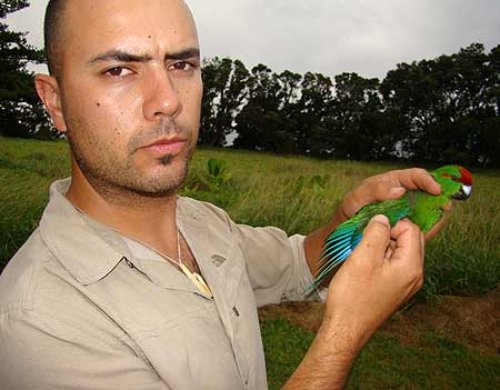 Luis Ortiz-Catedral holding a kakariki on Raoul Island, where he studied them last year.A biology doctoral researcher whose work has seen the return of endangered kakariki, or red-crowned parakeets, to two Hauraki Gulf islands and Auckland's mainland has won two awards.
Luis Ortiz-Catedral holding a kakariki on Raoul Island, where he studied them last year.A biology doctoral researcher whose work has seen the return of endangered kakariki, or red-crowned parakeets, to two Hauraki Gulf islands and Auckland's mainland has won two awards.
Luis Ortiz-Catedral, who has nearly completed his PhD research on the effects of translocating kakariki, has won a Claude McCarthy Fellowship for the second year running, and a Bob Steward Environmental Award from the Remuera Rotary Club.
Mr Ortiz-Catedral, based at the Institute of Natural Sciences in Albany, says the Claude McCarthy Fellowship, valued at $3000, will enable him to travel to the prestigious International Ornithological Congress this August in Brazil, where he will present his findings on the translocation of kakariki.
He says the success of the project has sparked interest among bird conservationists in island nations elsewhere in the world, particularly Norfolk Island and New Caledonia where other similar species of endangered parakeets could be translocated to nearby islands to form new colonies, as well as in Mexico, his homeland.
"The congress is the Olympic Games of the ornithological world – it takes place only every four years," he says. "There will be around 2000 of the world's very best bird researchers coming together in a single week. It's a really great opportunity to talk to a wider audience about the work we are doing in New Zealand."
The Bob Steward Environmental Award, worth $5000, will go towards the cost of translocating 50 kakariki in April from Little Barrier Island to Tawharanui Regional Park's protected open sanctuary. It will be the third and last transfer of the birds from Hauturu (Little Barrier Island) he has organised as part of his research in conjunction with the Department of Conservation. The first was in 2008, when 49 parakeets were flown by helicopter to pest-free Motuihe Island. They have been successfully breeding there ever since. Last year, 24 of the bright green parakeets were transferred to Tawharanui, but many appear to have moved to other areas, with sightings at Mangawhai and Kawau Island.
Kakariki have also been seen on Motutapu Island, which adjoins Rangitoto Island. Both islands are on target to becoming pest-free, after a campaign was launched last year. Mr Ortiz-Catedral says he is surprised at how quickly the parakeets have spread. "They are quite unusual in the parrot world – they can adapt to forest or grasslands, are flexible in their diet and are very fast in reaching sexual maturity. They are ready to breed within months of fledging, and they have heaps of chicks."
Kakariki were once widespread and found in such large numbers they were culled as orchard pests, but are now almost exclusively restricted to offshore islands free of introduced predators such as cats, rats, stoats and ferrets.